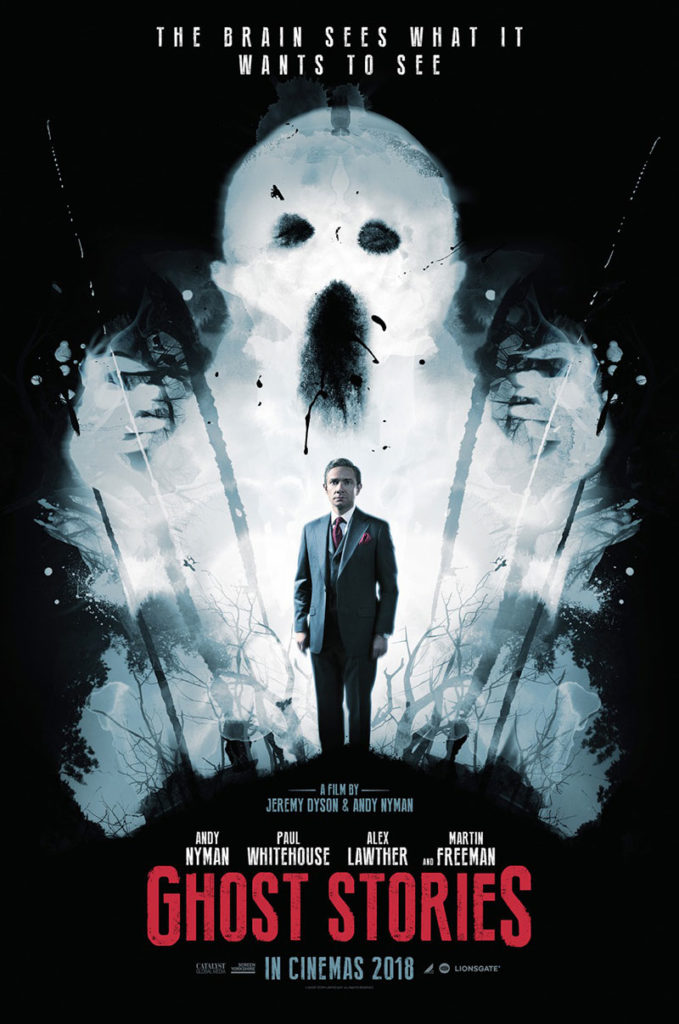Adapting their own successful stage play, writers and directors Andy Nyman and Jeremy Dyson have crafted a ghost flick that is, at times, among the most frightening that has been made this decade, and at other times is a cataclysmic rush to an uneven finale.
From 2017, Ghost Stories is somewhat of an anthology film, but the three separate tales that make up the film are bound together by a wrapper story in such a way that it can be considered a single narrative, as well. Nyman plays Professor Phillip Goodman, the presenter of a British reality show that debunks psychics. In an early scene, viewers see Goodman expose a spirit medium as a fraud.
Later, we learn that Goodman first began debunking the supernatural because he was influenced by an investigator from the 1970s named Charles Cameron, who also set out to expose fakes and frauds. Cameron has been missing for years, perversely adding to Goodman’s fascination with his work.
One evening, a package is slipped through Goodman’s mail slot. Inside is a photograph of an old man holding that day’s newspaper, and a cassette tape. It’s not a kidnapping and ransom demand, however. The photo and tape are from the missing Charles Cameron, asking Goodman to meet him at his trailer. There, it is revealed that Goodman is dying. He presents Goodman with files detailing three cases of the supernatural that Cameron was not able to debunk. This has led Cameron to doubt his life’s work, and he begs Goodman to investigate these cases and bring Cameron some peace before death. Thus, the anthology part of the movie is set up.
The first ghost story follows Paul Whiteside as Tony Matthews, a night watchman at an abandoned asylum. It’s a creepy and decayed place. Matthews has been there for years, and while some other watchmen have quit after having seen things, Matthews has never encountered anything strange. All that changes, as Matthews  has one of the more terrifying experiences I’ve ever seen in a ghost film. Seriously, this is eerie stuff. For horror fans who get the best creepy-crawlies from ghost flicks, this sequence will get them their fix. This sequence is also where the film peaks, however.
has one of the more terrifying experiences I’ve ever seen in a ghost film. Seriously, this is eerie stuff. For horror fans who get the best creepy-crawlies from ghost flicks, this sequence will get them their fix. This sequence is also where the film peaks, however.
The rest of the film isn’t bad. In fact, overall, Ghost Stories is quite good. It’s just frontloaded. The remaining two tales, and the wider narrative, aren’t nearly as frightening or as tense as this first ghostly encounter. Oh, well.
To make up for the dip in effectiveness, the next story features the best performance in the film. Alex Lawther plays Simon Rifkind, a young man who had his supernatural experience while driving at night on a country road.
When Goodman meets him, Simon is frantic and sleep-deprived. The event he witnessed has left him obsessed with demons and the occult. His bedroom is plastered wall to wall with illustrations of goat-headed creatures and strange symbols. Simon gives off waves of paranoia and fear. Whatever happened to him, it appears to have shattered his mind.
Simon’s encounter is swift, taking up a small chunk of the 98-minute running time, and not much happens. While driving and talking on the phone, Simon hits a goat-like creature with some human characteristics. There’s not much more to it. The pleasure in this sequence isn’t in what happens in any given scene. Rather, it’s watching Lawther ply his trade. His character is wound tighter than a steel cable, but also absurd. The film didn’t need it, but Lawther’s portrayal has a fair amount of levity.
The third ghost tale follows Martin Freeman as Mike Priddle, a moneyman who had encounters with a poltergeist in his home. This sequence, while not being as swift as Lawther’s, still has the same feeling of incompleteness. We see Freeman in his house and we see the poltergeist fooling around a little bit, but not much else. It’s as if the second and third stories were cut to pieces in post to bring down the running time.
Afterwards is a closing act where loose ends are introduced and then tied up, and viewers get a plot twist, to boot.
The spiritual goings on in this film will be familiar to those who have seen even a handful of ghost films. Where the film really works is its frights. There was something of a reliance on jump scares, but Nyman, Dyson and company did a very good job of not telegraphing when these scares would occur. The biggest problem with jump scares is that they are so predictable, and are a sign of lazy and/or incompetent filmmaking. Here, they are used to effect, as evidenced by the fact that this very experienced horror film watcher and reviewer was caught out many times by them.
Ghost Stories is good, but it is an up and down film. Had the second and third stories been fleshed out, and a little more chopped from the wrapper story, I think it would have been a stronger film.
